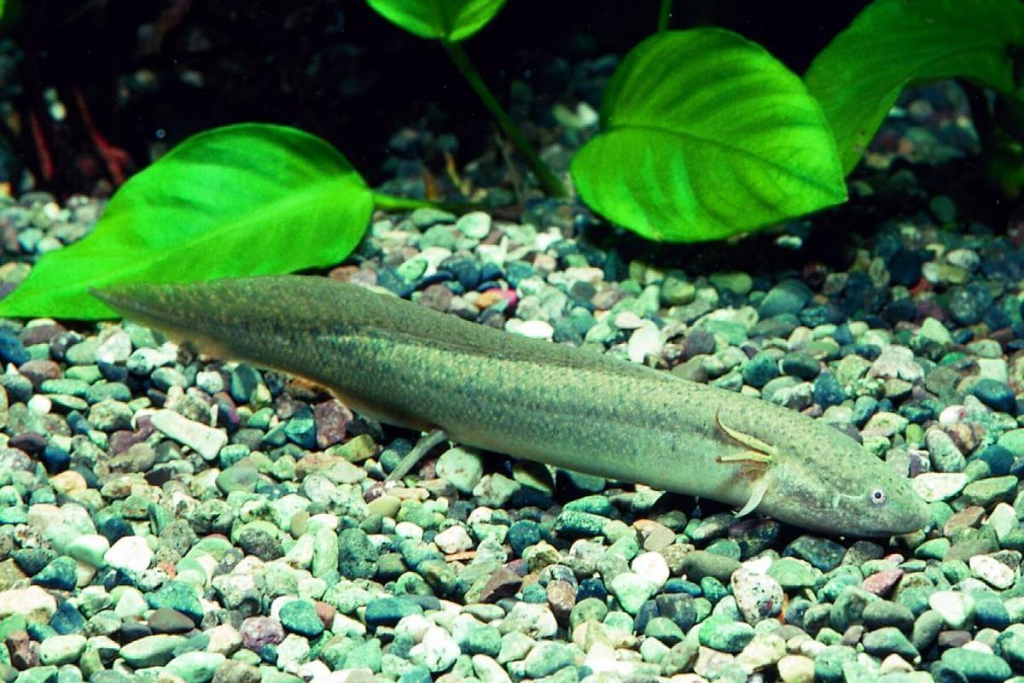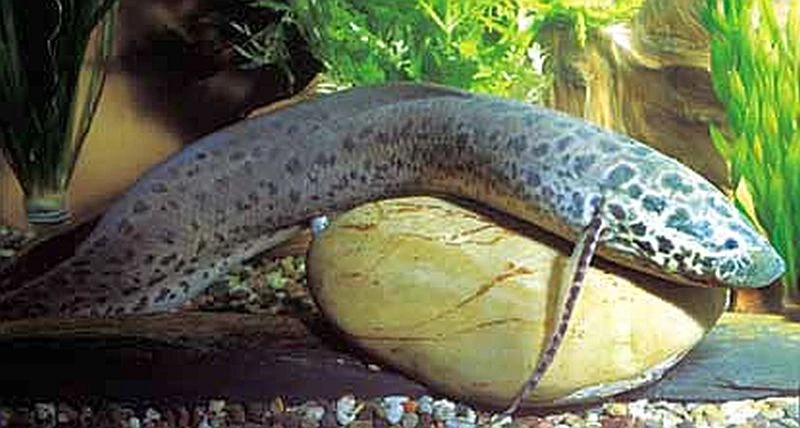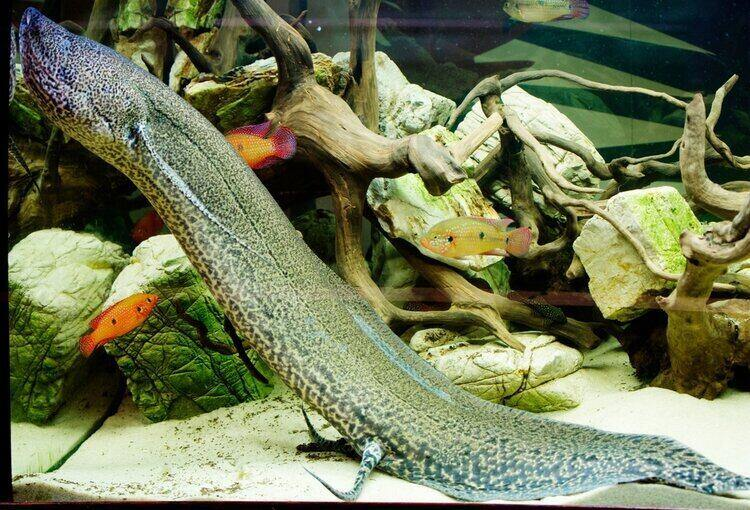Did you know that while there are nearly 32,000 species of fish on Earth, only one can survive outside of water? The African lungfish (Protopterus) is a truly extraordinary species, capable of thriving both underwater and on land, making it one of the most unique creatures on the planet. In this article, we’ll explore the fascinating biology and survival strategies of the African lungfish and how it has adapted to the harsh conditions of its native environment.
What Makes the African Lungfish So Unique?

The African lungfish is a genus of fish found in the rivers and lakes of sub-Saharan Africa. It’s a species with some of the most bizarre and remarkable biological characteristics in the animal kingdom. Despite being a fish, it has developed the ability to survive in environments that would be lethal to most aquatic species.
Physical Characteristics of the African Lungfish
African lungfish grow to impressive sizes, ranging from 44 cm to 200 cm when fully mature. With their elongated bodies, they resemble eels in appearance. The pectoral and anal fins of these fish are thread-like, and their dorsal and caudal fins are fused into a single structure, adding to their unusual look.
Unlike most fish, which are equipped with scales that provide a protective barrier, the lungfish is covered with soft, smooth scales. They move through the water in an undulating motion, similar to eels, but can also crawl along the bottom using their pectoral fins.
What truly sets the African lungfish apart, however, is its unique respiratory system that allows it to breathe both in water and on land.
A Unique Respiratory System: How Lungfish Breathe
As their name suggests, lungfish possess lungs, unlike most fish that rely solely on gills to extract oxygen from the water. This extraordinary adaptation allows them to survive in low-oxygen environments and even spend extended periods out of water. Lungfish have a highly developed respiratory system that enables them to extract oxygen directly from the air, just like land animals do.
In the wild, lungfish often come to the surface of the water to gulp air. However, unlike most fish, they can actually drown if they remain submerged for too long. This ability to breathe air gives the lungfish an incredible advantage in environments where water quality fluctuates or dries up completely, as is the case in many parts of Africa.

Surviving the Dry Season: The Lungfish’s Amazing Adaptation
One of the most remarkable survival strategies of the African lungfish comes into play during the dry season. In Africa, the weather can be incredibly harsh, and some rivers and lakes dry up for months at a time. This is where the lungfish truly shines. When water sources dry up and the temperature rises, the lungfish digs deep into the soft mud at the bottom of rivers or lakes. Using its powerful pectoral fins, it burrows down to a depth where water is still present.
Once it reaches the required depth, the lungfish stops digging and begins secreting mucus from its mouth. This mucus hardens to form a protective cocoon around the fish, which helps it survive in a dormant state until the next rainy season. The only part of the lungfish that remains exposed to the air is its mouth, allowing it to continue breathing. This cocoon can be so sturdy that the lungfish can remain in it for months, even up to an entire year, without needing to return to the water.
This survival tactic is nothing short of miraculous. By essentially “hibernating” in a mud cocoon, the lungfish can withstand droughts and extreme heat until the rainy season replenishes its habitat with fresh water. When the rains return, the lungfish emerges from its cocoon and resumes its normal life cycle, feeding and swimming as it did before.
The Habitat of the African Lungfish
Native to sub-Saharan Africa, lungfish live in the rivers, lakes, and wetlands of regions that experience seasonal dry spells. The environments they inhabit can vary from slow-moving freshwater streams to stagnant pools of water. The dry season, which can last for months, creates challenges for many species, but the African lungfish has adapted in such a way that it not only survives but thrives in these extreme conditions.
Lungfish are typically found in places like the Congo River, Lake Tanganyika, and various other bodies of water across Africa. These regions can experience extreme temperature fluctuations, with water levels rising and falling dramatically. The ability of the lungfish to survive in both water and land conditions makes it a true testament to the adaptability of nature.
How the African Lungfish Compares to Other Fish Species
There are many fascinating fish species across the world, but none have evolved quite like the African lungfish. While many fish have evolved specialized features such as the ability to live in deep, dark waters or withstand freezing temperatures, only the lungfish has developed the ability to spend extended periods outside of water.

Most fish species depend heavily on water to survive. Their gills extract oxygen from the water, which makes them highly susceptible to environmental changes. If the water temperature rises too high, oxygen levels drop, or if the water dries up, most fish face an immediate threat to their survival. However, the African lungfish has adapted to these challenges by evolving a unique method of air-breathing, giving it the ability to survive in conditions that would be fatal to most other fish.
Why the African Lungfish is So Important to Science
The African lungfish is not just a marvel of nature; it also offers valuable insights into the evolution of vertebrates. Scientists believe that the lungfish is closely related to the ancestors of land-dwelling animals, and studying this fish can help researchers understand how vertebrates made the transition from water to land millions of years ago. The lungfish is often considered a “living fossil,” and its ability to survive both in water and on land makes it an essential species for evolutionary biology.
By examining the lungfish’s respiratory system and its unique adaptations, scientists can learn more about the mechanisms that allowed early fish to evolve into the first land-dwelling creatures, shedding light on one of the most important events in the history of life on Earth.
Conclusion: The Marvel of the African Lungfish
The African lungfish is a living testament to the power of adaptation and survival. With its ability to breathe both in water and on land, it stands as a symbol of nature’s ingenuity. Whether it’s digging into the mud to endure the dry season or using its specialized lungs to extract oxygen from the air, the lungfish has evolved to thrive in one of the harshest environments on Earth. As one of the only fish species capable of surviving without water, the African lungfish continues to fascinate scientists and nature enthusiasts alike, proving that life finds a way, even in the most extreme conditions.


